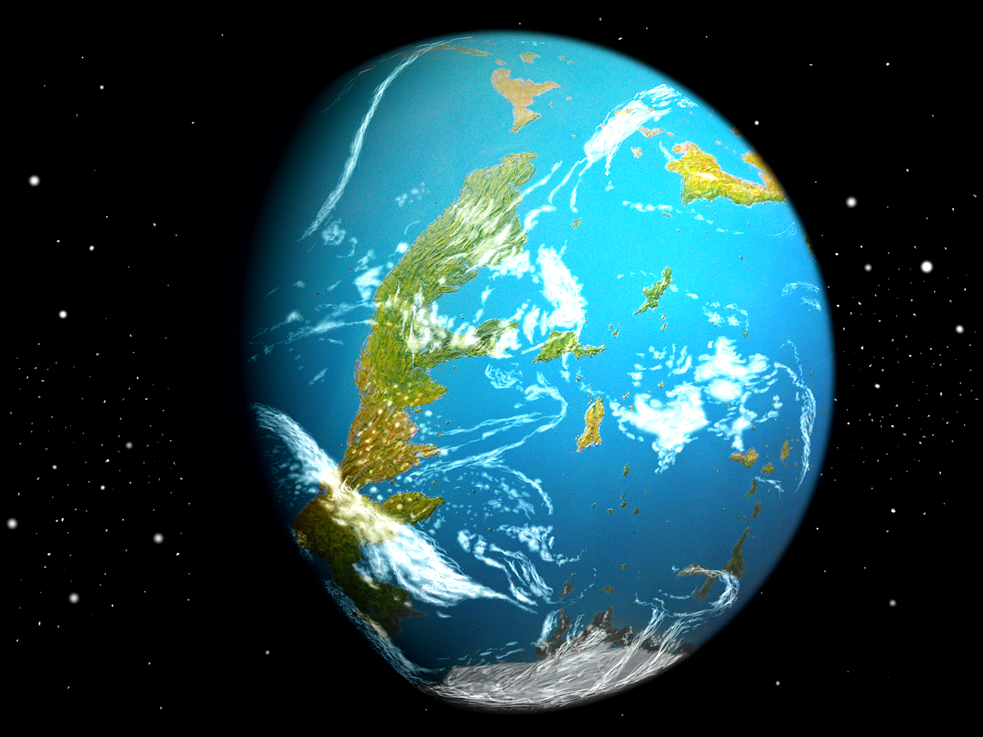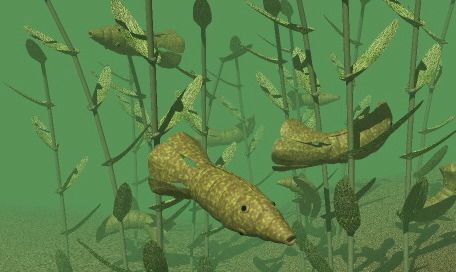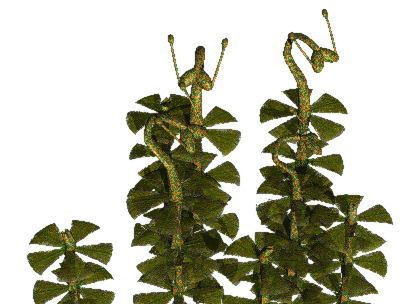Geology
Understanding the geological evolution of Epona is the key to appreciating its distinctiveness - those differences that render the world alien and not just another Earth.
Epona is 55% the mass of the Earth and 85% the size roughly speaking a compromise between Earth and Mars. Its surface to volume ratio is thus greater than the Earth but smaller than that of Mars and so, given a similar inventory of radioactive elements, it will lose its internal heat at an intermediate rate between the two. At an age of 5 billion years, the Taranis system is 400 million years older than our own. Epona has had a lot of time to grow old and that is in fact what has happened.
Epona was formed at a distance from its primary of only slightly greater than the equivalent (in terms of insolation) of Earth from the Sun. Its material constitution was similar, having a liquid iron core, rocky outer layers and a watery surface. Up to ~1.7 billion years ago the geological activity on Epona was strong and continuous. Crustal plates, like on the Earth, moved slowly over the planet, being formed at volcanically active spreading centers and recycled back into the depths of the planet at subduction zones. Continents, ocean basins and a differentiated crust rich in mineral deposits were formed. Conditions were perfect for life which soon originated and gradually converted the atmosphere to an oxygen-rich composition. Slightly faster than on the Earth, 'multicellular' life forms evolved and advanced on to the land. Epona resembled a slightly smaller Earth.
 The key to this ~ 3.3 billion year period of warmth and stability was the constant volcanic and tectonic activity which permitted a closed carbonate-silicate cycle. Carbon dioxide, an important greenhouse gas, dissolves in rainwater to form carbonic acid which weathers silicate rock to form carbonates óa particularly common form being limestone. However, the continual burial of rock to depths where the heat is such that the CO2 is driven out recycles this essential gas back into the atmosphere. What's more is that the weathering part of the cycle is sensitive to surface temperature allowing a stabilizing negative feedback loop to operate that maintains a pleasant climate. If the planet heated up, weathering would increase, drawing down CO2, reducing the greenhouse effect and thereby cooling the planet. If the planet were to cool, weathering slows down, but the rate of volcanic release stays the same, the amount of CO2 increases and the planet heats up. Stars slowly increase in brightness as they age and so the equilibrium proportion of CO2 in the atmosphere gradually falls over billions of years, as the quantity of radiation received by the planet increases. The important thing to note though is that an operative carbonate-silicate cycle stabilizes the climate on timescales much shorter than this. Although conditions may fluctuate, the oceans neither boil nor completely freeze over (so long as the planet did not form close to the inner edge of the ecosphere). This is an important feature of the Earth's climate and prior to ~ 1.7 billion years ago the habitability of Epona was also assured by this geochemical mechanism.
The key to this ~ 3.3 billion year period of warmth and stability was the constant volcanic and tectonic activity which permitted a closed carbonate-silicate cycle. Carbon dioxide, an important greenhouse gas, dissolves in rainwater to form carbonic acid which weathers silicate rock to form carbonates óa particularly common form being limestone. However, the continual burial of rock to depths where the heat is such that the CO2 is driven out recycles this essential gas back into the atmosphere. What's more is that the weathering part of the cycle is sensitive to surface temperature allowing a stabilizing negative feedback loop to operate that maintains a pleasant climate. If the planet heated up, weathering would increase, drawing down CO2, reducing the greenhouse effect and thereby cooling the planet. If the planet were to cool, weathering slows down, but the rate of volcanic release stays the same, the amount of CO2 increases and the planet heats up. Stars slowly increase in brightness as they age and so the equilibrium proportion of CO2 in the atmosphere gradually falls over billions of years, as the quantity of radiation received by the planet increases. The important thing to note though is that an operative carbonate-silicate cycle stabilizes the climate on timescales much shorter than this. Although conditions may fluctuate, the oceans neither boil nor completely freeze over (so long as the planet did not form close to the inner edge of the ecosphere). This is an important feature of the Earth's climate and prior to ~ 1.7 billion years ago the habitability of Epona was also assured by this geochemical mechanism.However, since that time, because of the planet's smaller size and more rapid heat loss, its crust has cooled and thickened to the extent that it became static. The continuous conveyor belt of crustal creation, destruction and recycling ceased. Over the millions of years since, mountain building slowed or stopped altogether, and the land surface started eroding down at a faster rate than it was being uplifted. Mountains crumbled into the sea; the land largely flooded and the oceans became more saline and filled with silt. The carbonate-silicate cycle was cut, its return volcanic branch from mineral to gaseous phase now operating at a much lower rate. Temperature regulation faltered, the much reduced CO2 greenhouse effect could not prevent ice sheets advancing from the poles down to low latitudes. Where life was not physically obliterated from the land surfaces by glaciers, the biota mostly died off and reverted almost to bacterial level when the concentration of CO2 fell too low for productive photosynthesis. Although life was still reasonably abundant and diverse in the seas, the cutting of Epona's ability to self-regulate its atmosphere and temperature resulted in its biosphere crashing into an impoverished and moribund state.
Not a very hopeful prospect . . . but not all is lost! Although its crustal plates have thickened and are permanently locked together, the interior of Epona is far from stone cold. Hot spots build up at the base of the crust and, every 100 million years or so, cause a quite abrupt and violent spasm of terminal volcanism. Huge quantities of lava and gas are released; new volcanic highlands form and ash darkens the ice fields below; the CO2 concentration in the atmosphere is boosted over ten-fold; quite rapidly, once a certain trigger point is reached, ice retreats back to the poles exposing fresh land surfaces. The biosphere is temporarily rejuvenated- these warm times of plenty giving the land biota a new lease of life for about 10 million years before the volcanism ceases and the next ice die-out occurs.
There have been about 20 of these cycles of biospheric 'near-death-experience' and 'revival' and our exploration of Epona takes place towards the end of one of the last of these warm spells. In the soon-to-come geological future, the weakening volcanism will no longer be able to break through the ever-thickening crust. Epona will become quiescent for good.

Ecology
The ecology of Epona obviously depends crucially on the long-term cycles in the climate described above. To illustrate how, we might speculate over the fate of life during one complete cycle.
Imagine the last warm spell. In ten million years the ecology of Epona has recovered to become almost as complex as on Earth. Land and marine biota are in a state of climax - production by plants is balanced by consumption by animal and decay organisms. Then, with the waning of outgassing, the CO2 deficit becomes felt, the planet starts to freeze, glaciating high to mid latitudes, and bulldozing away land-based life. What's worse is that eventually CO2 falls to the extent that photosynthesis on what land remains ice-free becomes very difficult. Ecosystems begin to unravel, consumption outstrips production, and when excess biomass has gone we are left with a very impoverished biota. Most members of the previous ecosystems are extinct, what remains is a tundra-like landscape with sparse soil amongst eroded rocks - a desert where one might think a desert ought not to be - supporting a scum of sparse life recycling its scarce raw materials in tight and intimate cycles.
 The seas and their edges are different. Carbon dioxide is buffered in the waters by the presence of abundant carbonate sediments and the fact that organisms that live in the rich mud on the sea bottom consume and recycle carbon and other nutrients very efficiently. Photosynthesis in the upper waters thus goes on almost as well as it has ever done and, like on Earth, turnover of plant matter is very rapid supporting a large animal biomass. Epona during these times is like a global Antarctica - little life on land, except on the shoreline, but plenty in the sea.
The seas and their edges are different. Carbon dioxide is buffered in the waters by the presence of abundant carbonate sediments and the fact that organisms that live in the rich mud on the sea bottom consume and recycle carbon and other nutrients very efficiently. Photosynthesis in the upper waters thus goes on almost as well as it has ever done and, like on Earth, turnover of plant matter is very rapid supporting a large animal biomass. Epona during these times is like a global Antarctica - little life on land, except on the shoreline, but plenty in the sea.A hundred million years after the retreat of complex life into the sea, the next volcanic episode brings on a new warm spell. The ice falls back and abundant CO2 is now present to support photosynthesis and biomass production. Vast and almost lifeless land surfaces are exposed- vacant ecological niches aplenty for a veritable evolutionary eruption! This is the sort of biosphere from which we evolved our biota and sophont! We had a wild, roller-coaster, ten million years of explosive evolution to populate the land with plants and animals designed for marine, or semi-marine life. (Note that on Earth, after the Cretaceous mass extinction, the first epoch of the Cenozoic, the Paleocene, which was 10.1 million years long, witnessed a rapid diversification of mammals into the vacant niches left by the dinosaurs.) Just like with the aftermath of a mass extinction or the opening of new land, contingency (chance) reigns supreme. The merest fluke might select one clade for dominance in the new niches and doom another. This gave us the greatest choice for design one can imagine - a Burgess shale style radiation, followed by decimation of diversity and the choice of just a few body plans on which to build all that is to come.
Every 100 million years the die is cast anew and a fresh group of creatures gets a shot at a brief dominance on land. If a sophont evolves in time before disaster, then perhaps technology might prolong Epona's final Summer.



